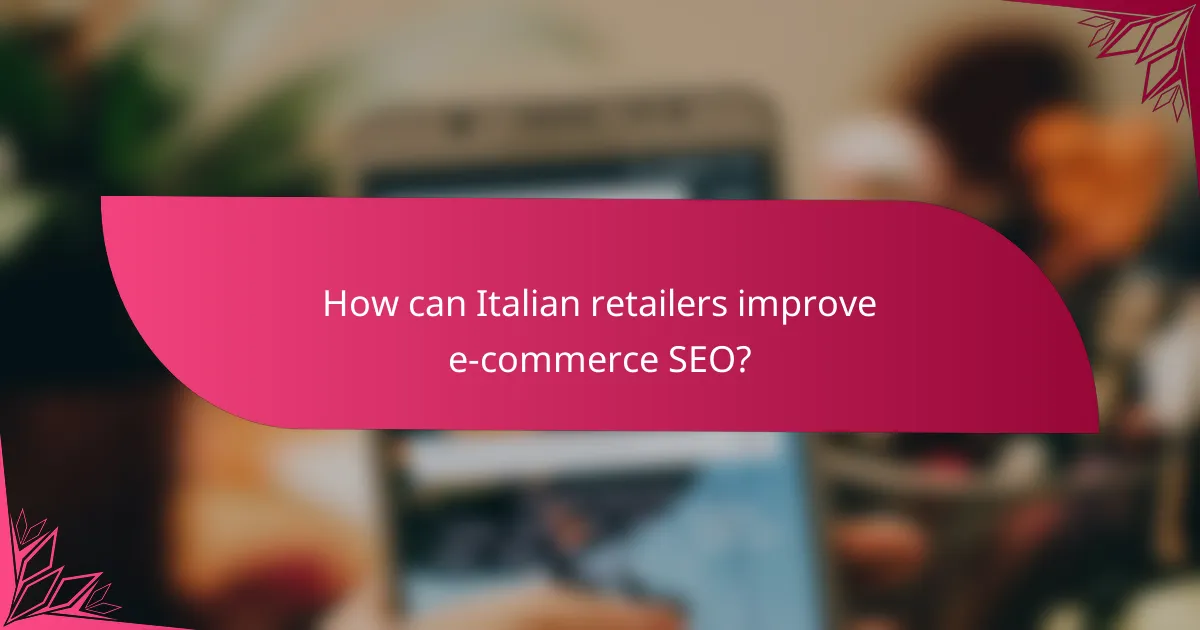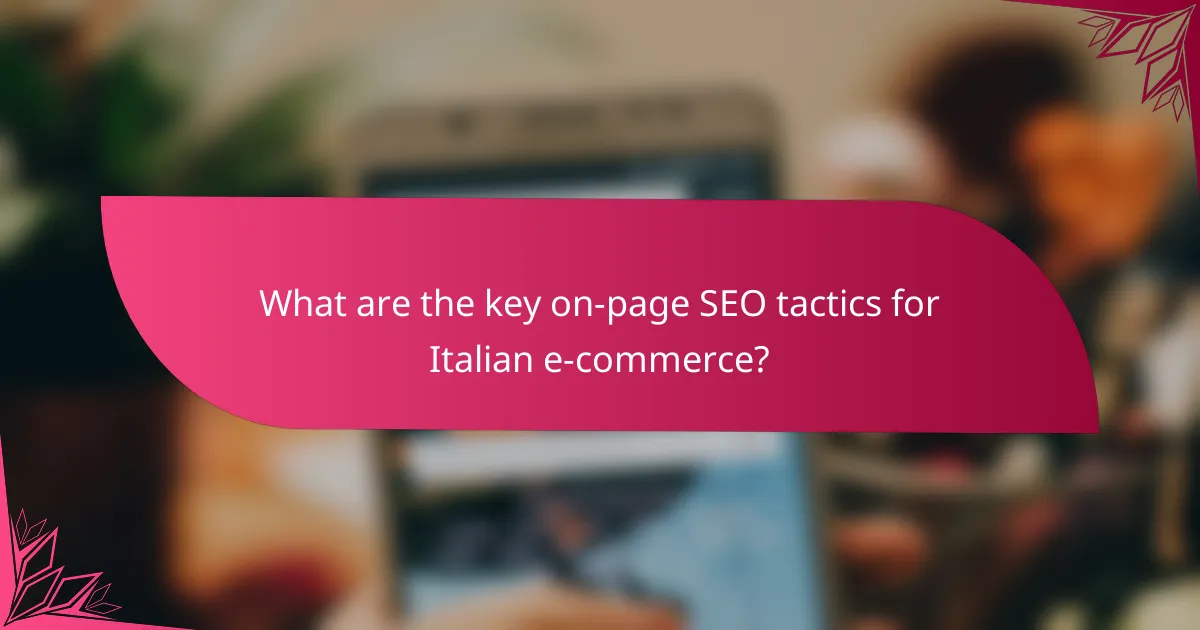Italian retailers looking to boost their e-commerce presence can significantly benefit from implementing effective SEO strategies. By focusing on local search optimization, utilizing high-quality images, and enhancing mobile usability, retailers can attract more relevant traffic and improve their visibility in search engine results. Additionally, employing key on-page SEO tactics and engaging in content marketing will further enhance their online performance and drive sales.

How can Italian retailers improve e-commerce SEO?
Italian retailers can enhance their e-commerce SEO by focusing on local search optimization, implementing schema markup, improving mobile usability, utilizing high-quality images, and ensuring fast page load times. These strategies will help attract more relevant traffic and improve visibility in search engine results.
Optimize for local search
To optimize for local search, Italian retailers should ensure their business information is accurate and consistent across all online platforms. This includes updating Google My Business listings with the correct address, phone number, and operating hours.
Incorporating local keywords into product descriptions and metadata can also enhance visibility. For example, using terms like “scarpe online Roma” can help target customers searching for shoes in Rome.
Implement schema markup
Schema markup helps search engines understand the content of a website better, which can improve search visibility. Italian retailers should implement structured data for products, reviews, and local business information.
Using schema can lead to rich snippets in search results, such as star ratings and pricing, which can increase click-through rates. Tools like Google’s Structured Data Markup Helper can assist in adding this markup effectively.
Enhance mobile usability
With a significant portion of online shopping occurring on mobile devices, enhancing mobile usability is crucial. Italian retailers should ensure their websites are responsive, meaning they adapt seamlessly to various screen sizes.
Additionally, simplifying navigation and optimizing buttons for touch can improve the user experience. Testing the website on multiple devices can help identify and resolve usability issues.
Utilize high-quality images
High-quality images are essential for e-commerce success, as they can significantly influence purchasing decisions. Italian retailers should use clear, well-lit images that showcase products from multiple angles.
Including zoom functionality and lifestyle images can also enhance the shopping experience. It’s advisable to compress images to balance quality and loading speed.
Focus on page speed
Page speed is a critical factor for both user experience and SEO. Italian retailers should aim for load times under three seconds to minimize bounce rates and improve rankings.
To enhance page speed, retailers can optimize images, leverage browser caching, and minimize server response times. Tools like Google PageSpeed Insights can provide actionable recommendations for improvement.

What are the key on-page SEO tactics for Italian e-commerce?
Key on-page SEO tactics for Italian e-commerce include using relevant keywords, crafting compelling meta descriptions, and optimizing product titles. These strategies help improve visibility in search engines and attract potential customers to your online store.
Use relevant keywords
Identifying and using relevant keywords is crucial for Italian e-commerce success. Focus on terms that your target audience is likely to search for, including local dialects or specific product names. Tools like Google Keyword Planner can help you find popular search phrases.
Incorporate these keywords naturally into your product descriptions, headings, and URLs. Avoid keyword stuffing, as this can harm your rankings. Aim for a keyword density of around 1-2% for optimal results.
Craft compelling meta descriptions
Meta descriptions serve as a brief summary of your page content and play a vital role in attracting clicks from search results. Write clear, concise descriptions that include your primary keywords and highlight unique selling points of your products.
Keep your meta descriptions within 150-160 characters to ensure they display fully in search results. Use action-oriented language to encourage users to click, such as “Shop now” or “Discover exclusive deals.” Regularly update these descriptions to reflect changes in inventory or promotions.
Optimize product titles
Product titles are one of the first elements customers see, making them essential for both SEO and user experience. Include relevant keywords while ensuring the title is descriptive and engaging. A good format is to start with the product name followed by key features or specifications.
Avoid overly long titles; aim for around 50-60 characters to ensure they display well in search results. Consider including brand names and specific attributes, such as size or color, to enhance search relevance and appeal to potential buyers.

How to leverage content marketing for e-commerce SEO?
Content marketing is essential for enhancing e-commerce SEO, especially for Italian retailers. By creating valuable, relevant content, you can improve your website’s visibility, engage customers, and drive sales.
Create engaging blog posts
Blog posts can significantly boost your e-commerce SEO by providing informative content that attracts visitors. Focus on topics relevant to your products and audience, such as fashion trends, product guides, or industry news. Aim for posts that are at least 800 words long to improve search engine rankings.
Incorporate keywords naturally throughout your blog posts, including in headings and subheadings. Use tools like Google Keyword Planner to identify popular search terms in Italy that relate to your niche.
Utilize video content
Video content is increasingly important for e-commerce SEO, as it can enhance user engagement and time spent on your site. Create product demonstrations, tutorials, or customer testimonials that resonate with your audience. Aim for videos that are 1-3 minutes long to maintain viewer interest.
Optimize your video titles and descriptions with relevant keywords to improve search visibility. Consider hosting videos on platforms like YouTube, which can drive additional traffic back to your e-commerce site.
Implement user-generated content
User-generated content (UGC) can enhance your e-commerce SEO by providing authentic reviews and testimonials. Encourage customers to share their experiences through reviews, photos, or social media posts. Highlight this content on your product pages to build trust and credibility.
Incorporate UGC into your marketing strategy by creating a dedicated section on your website for customer stories or featuring user photos on social media. This not only boosts SEO but also fosters a sense of community around your brand.

What role does social media play in e-commerce SEO?
Social media significantly impacts e-commerce SEO by driving traffic and enhancing brand visibility. By leveraging social platforms, retailers can improve their search engine rankings and connect with potential customers more effectively.
Drive traffic through social channels
Utilizing social media channels can direct substantial traffic to your e-commerce site. Sharing product links, promotions, and engaging content on platforms like Facebook, Instagram, and TikTok can attract users who may not have discovered your brand through traditional search engines.
Consider integrating social sharing buttons on your product pages to encourage visitors to share items with their networks. This can lead to organic traffic growth, as shared content often reaches a wider audience.
Enhance brand visibility
Social media enhances brand visibility by allowing retailers to engage directly with their audience. Regularly posting updates, responding to comments, and participating in conversations can build a loyal community around your brand.
Utilize visually appealing content, such as high-quality images and videos, to showcase your products. Engaging storytelling can resonate with your audience, making your brand more memorable and increasing the likelihood of conversions.

How can Italian retailers utilize Google My Business?
Italian retailers can effectively utilize Google My Business (GMB) to enhance their online presence and attract local customers. By optimizing their GMB listings, retailers can improve visibility in local search results, showcase their products, and engage with customers directly.
Claim and verify business listing
Claiming and verifying a Google My Business listing is the first step for Italian retailers. This process involves creating an account and providing accurate business information, such as the name, address, phone number, and operating hours. Verification can be completed via mail, phone, or email, ensuring that the business is recognized by Google.
Once verified, retailers should regularly update their listings with any changes in hours or services. This helps maintain accuracy and improves customer trust. For example, if a store offers special holiday hours, updating this information promptly can attract more visitors.
Encourage customer reviews
Encouraging customer reviews is crucial for building credibility and attracting new customers. Retailers can ask satisfied customers to leave positive feedback on their GMB listing, which can significantly influence potential buyers. Aiming for a mix of reviews can help create a balanced and trustworthy profile.
To facilitate this, retailers might consider sending follow-up emails after purchases or providing incentives, such as discounts on future purchases, for leaving a review. However, it’s essential to avoid any practices that could be seen as manipulating reviews, as this could violate Google’s guidelines and harm the business’s reputation.

What are the best practices for e-commerce site architecture?
Effective e-commerce site architecture is crucial for enhancing user experience and improving search engine rankings. A well-structured site allows visitors to navigate easily, find products quickly, and helps search engines index pages efficiently.
Implement a clear navigation structure
A clear navigation structure is essential for guiding users through your e-commerce site. Use a simple, hierarchical layout that categorizes products logically, allowing customers to find what they need without frustration. For example, main categories can include Electronics, Clothing, and Home Goods, each with subcategories like Mobile Phones or Men’s Apparel.
Consider using drop-down menus for subcategories to keep the interface clean. Ensure that the most popular categories are easily accessible from the homepage, as this can significantly reduce bounce rates and improve conversion rates.
Use breadcrumb navigation
Breadcrumb navigation enhances user experience by showing users their current location within the site hierarchy. This feature allows customers to backtrack easily to previous categories or the homepage, which is particularly useful in larger e-commerce sites with extensive product ranges.
Implement breadcrumb trails that reflect the path taken, such as Home > Electronics > Mobile Phones. This not only aids navigation but also provides additional context for search engines, potentially improving SEO. Ensure that breadcrumbs are visible on all product pages to maximize their utility.

How to analyze e-commerce SEO performance?
To analyze e-commerce SEO performance, focus on key metrics such as organic traffic, conversion rates, and keyword rankings. Regularly reviewing these indicators helps identify strengths and weaknesses in your SEO strategy.
Key performance indicators (KPIs) for e-commerce SEO
Key performance indicators (KPIs) for e-commerce SEO include organic traffic, bounce rate, average session duration, and conversion rate. Monitoring these metrics provides insights into how well your website attracts and retains visitors.
For instance, a high bounce rate may indicate that visitors are not finding what they expect, while a low conversion rate could suggest issues with the checkout process. Aim for organic traffic growth of at least 10-20% over several months as a benchmark for success.
Tools for tracking SEO performance
Utilize tools like Google Analytics, Google Search Console, and SEMrush to track SEO performance effectively. These platforms provide valuable data on traffic sources, user behavior, and keyword rankings.
For example, Google Analytics can help you analyze user engagement metrics, while Google Search Console offers insights into how your site appears in search results. Regularly check these tools to stay informed about your SEO health.
How to interpret SEO data
Interpreting SEO data involves analyzing trends and making informed decisions based on the insights gathered. Look for patterns in your traffic sources, keyword performance, and user behavior to identify areas for improvement.
For instance, if a specific product page sees a spike in traffic but low conversions, consider optimizing the page content or enhancing the user experience. Use data to prioritize your SEO efforts effectively.
